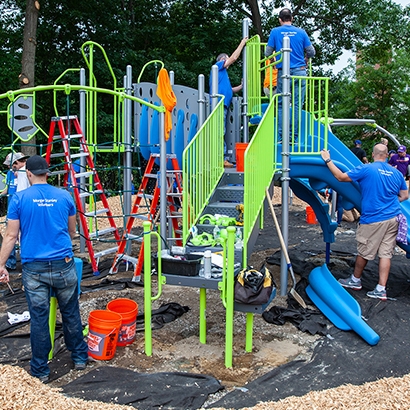After more than a decade running the annual Morgan Stanley Strategy Challenge, the program’s director offers nonprofits some lessons for engaging with volunteer consultants.
Nonprofit organizations often face growing pains, particularly around scale, and may need external help in finding the best solution to strategic questions. Eleven years ago, we started a program—the Morgan Stanley Strategy Challenge—that matches nonprofits with volunteer teams of our employees working together over 10 weeks to develop action plans that help address mission-critical issues.
Since then, our annual Strategy Challenge has helped over 125 nonprofits expand and improve their businesses, while also showcasing some of our firm's rising talent.
In that time, we've learned a few things that nonprofits can do to make the most of their time with pro bono consultants and strategic volunteers to maximize their experience and outcomes.
Here, based on my experience, are some tips for nonprofits that want to enjoy a successful engagement with a pro bono consulting partner.
1. Be specific. This isn't a time to ask vague or open-ended questions. The strategic challenge you present should have clear parameters and seek a specific conclusion.
For example, for many nonprofits, a major struggle is figuring out how to take an idea and scale it up. Maybe you are debating whether to grow your program geographically or add to your menu of services. Focus on whether to expand to the adjacent city or whether to add a specific service, rather than asking broader questions like: "Should I expand?" or "Should I add services?" Limiting the scope of the engagement to a specific query gives the volunteer consultants a discrete problem to solve.
2. Be realistic. Your volunteer consultants are helping you on top of their regular job responsibilities, and a few weeks or months isn’t a long time for them to tackle your most complex problems. This is one reason why it’s so important to define a specific question.
But your project’s scope also has to be appropriate, in terms of the defined time limits. You and the consultants should be able to develop an action plan within the allotted time frame, size of the team, amount of time the volunteers have to devote to the project, and the available information and data.
3. Be available. There's that saying, "You get what you give," and that is definitely true here. In our experience with the Strategy Challenge, the nonprofits that really invest their staff's time in the engagement—opening their doors to the volunteers and providing the necessary data and documentation during the projects—get the best results.
This is partly because the staff members of the nonprofits have been part of the process, taking on a level of ownership in the project and helping to guide the outcome, and partly because your availability allows the volunteers to really get to know your organization and its culture, gaining the context and insights they need to tailor advice for your organization.
4. Load up on data. It's important to go into the project with some research and numbers that show you've been thinking about the problem and have a few ideas to run past the volunteers. There are plenty of quantitative analysts who can help you sort through it.
Since the beginning of the Strategy Challenge, we have consistently found that boards more easily approve plans when supported by data and analytics. It's a simple matter of having the facts right there in front of them, making it an easier selling point for you and the consultants. Over the long term, board acceptance of a strategy is the best way to ensure implementation.
5. It's OK to be wrong. You probably have an idea of how to solve your nonprofit's challenges, especially if you are the founder. Maybe you think the consultants will review your case and confirm your thinking on the subject—but it’s also possible that the volunteer team considering your strategic idea ends up offering a different approach.
Don’t take it personally. When you agree to let others in on your thinking, make sure you are ready to accept both the positive and constructive feedback they may deliver. Their advice may be that now isn’t the right time to take a certain step or move in a certain direction—which may ultimately save you time, money and headaches.
6. Avoid mission creep. Although the volunteers are working with you on a specific project with time constraints, perhaps you can't help but notice how smart and skilled they are. You may be tempted to ask them to help solve other issues that your organization is grappling with. After all, they are already in your office, and it's easy enough to run something by them.
Try to resist this temptation. You don’t want to overload your pro bono team. And, even though they might want to, the volunteers won’t be able to handle the additional work. Be careful not to stray from your initial mandate by piling more issues on the consulting team, which can detract from your shared goals and compromise the end results.
7. Think long-term. The tone you set during your work with the volunteers opens the door to the future. Many consultants end up forging enduring personal connections with the organizations they support during a volunteer engagement, building a rapport with leadership and staff and establishing their own faith in your mission leading to continued involvement long after the project is complete. Cultivating that long-term relationship gives you a chance to seek advice and mentoring down the road.
8. A consulting project isn't about donations. Since you’re aiming for the long term, remember that a pro bono consulting engagement is just that—an opportunity to gain expert advice that groups outside the nonprofit world would pay a lot for. This isn't about soliciting donations for your group from the team or its contacts, so hold off on asking for financial support during the project.
In the future, your consultants may choose to donate to what they see to be a very worthy cause and they may one day be in a position to ask their friends, colleagues and other business associates to do the same. But don’t assume too much, and let the value of your mission and the strength of your organization do the talking, rather than trying to hard-sell these volunteers.
Remember, specific questions are easier to address than vague ones, reasonable expectations are more easily met than exhaustive lists of demands, and everyone involved is probably on the same page, in terms of wanting to make human connections and contribute meaningfully to a good cause. Have faith in the process, and you’ll come out ahead—as will your pro bono partners.




